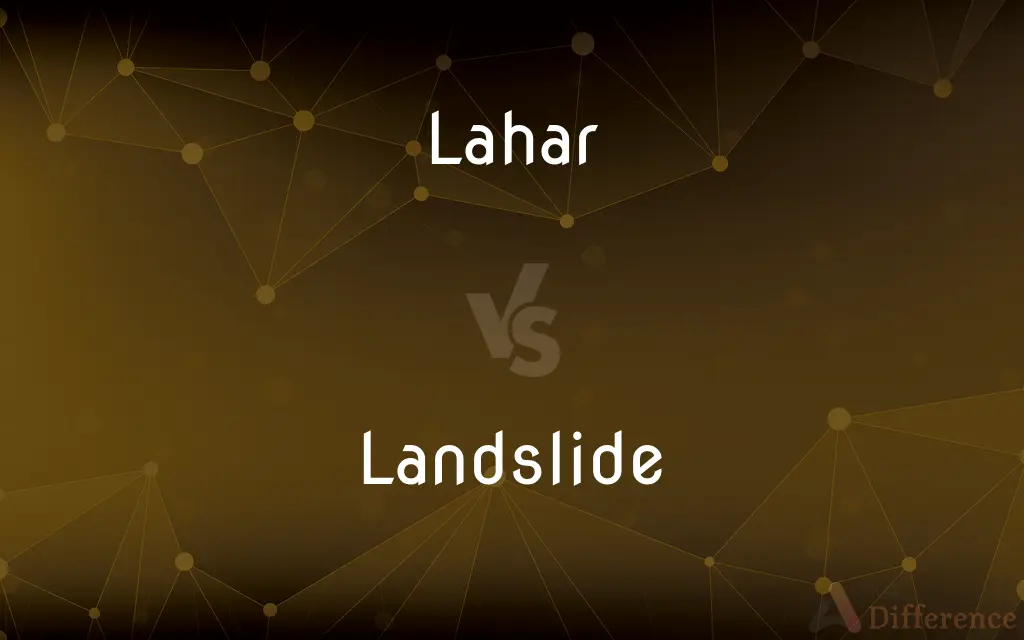Lahar vs. Landslide — What's the Difference?
By Maham Liaqat & Fiza Rafique — Updated on May 18, 2024
Lahar is a volcanic mudflow or debris flow, while a landslide is the movement of rock, earth, or debris down a slope.

Difference Between Lahar and Landslide
Table of Contents
ADVERTISEMENT
Key Differences
Lahar is a type of volcanic mudflow or debris flow that occurs when volcanic ash and debris mix with water, often from heavy rainfall, melted snow, or ice. Lahars can travel rapidly down river valleys, causing widespread damage and endangering communities. Landslide, on the other hand, refers to the movement of rock, earth, or debris down a slope due to gravity. Landslides can be triggered by various factors such as heavy rainfall, earthquakes, volcanic activity, or human activities like deforestation and construction.
Lahars are typically associated with volcanic activity and can occur suddenly, posing immediate risks to life and property. They are often more fluid and can travel farther distances than landslides. Landslides, however, are more broadly defined and can happen in various settings, from mountains to coastal cliffs.
While lahars are primarily composed of volcanic materials mixed with water, landslides can consist of any type of earth material, including soil, rocks, and vegetation. Both events can be devastating, but lahars are particularly dangerous due to their speed and the vast areas they can cover.
Lahars require a source of water to mobilize volcanic debris, while landslides are mainly driven by gravitational forces acting on unstable slopes. The presence of water is a key distinguishing factor between the two phenomena.
Comparison Chart
Definition
Volcanic mudflow or debris flow
Movement of rock, earth, or debris
ADVERTISEMENT
Cause
Volcanic activity and water
Gravity, often triggered by rainfall, earthquakes, etc.
Composition
Volcanic ash, debris, and water
Soil, rock, vegetation
Terrain
Typically volcanic regions
Any mountainous or hilly terrain
Speed and Range
Can travel rapidly and cover long distances
Varies, generally slower and covers shorter distances
Water Involvement
Essential for formation
Not always necessary
Compare with Definitions
Lahar
A fast-moving flow of volcanic material and water down a volcano's slopes.
Lahars can travel at speeds up to 50 km/h.
Landslide
An event where soil and rocks move rapidly down a hillside.
An earthquake triggered a landslide in the mountainous region.
Lahar
A secondary volcanic hazard involving mud and debris.
Even after the eruption, lahars pose a significant threat.
Landslide
A mass wasting event driven by gravity.
Landslides can occur without warning, causing significant damage.
Lahar
A volcanic mudflow composed of ash, debris, and water.
The eruption triggered a lahar that swept through the valley.
Landslide
A natural disaster involving the downward movement of earth material.
Deforestation can increase the risk of landslides.
Lahar
A destructive flow caused by the mixing of volcanic ash and water.
Heavy rain caused a lahar to form and inundate nearby villages.
Landslide
The collapse of a slope due to instability.
The landslide buried several homes under tons of debris.
Lahar
A volcanic phenomenon requiring water to mobilize debris.
Melting snowcaps on the volcano can trigger lahars.
Landslide
The movement of rock, earth, or debris down a slope.
The heavy rains caused a landslide that blocked the road.
Lahar
A lahar ( , from Javanese: ꦮ꧀ꦭꦲꦂ) is a violent type of mudflow or debris flow composed of a slurry of pyroclastic material, rocky debris and water. The material flows down from a volcano, typically along a river valley.Lahars are extremely destructive: they can flow tens of metres per second, they have been known to be up to 140 metres (460 ft) deep, and large flows tend to destroy any structures in their path.
Landslide
The term landslide or, less frequently, landslip, refers to several forms of mass wasting that may include a wide range of ground movements, such as rockfalls, deep-seated slope failures, mudflows, and debris flows. Landslides occur in a variety of environments, characterized by either steep or gentle slope gradients, from mountain ranges to coastal cliffs or even underwater, in which case they are called submarine landslides.
Lahar
A mass of volcanic fragments, often mixed with water, moving rapidly down the side of a volcano.
Landslide
The downward sliding of a relatively dry mass of earth and rock.
Lahar
The deposit produced by a lahar.
Landslide
The mass that slides. Also called landslip.
Lahar
(geology) A volcanic mudflow.
Landslide
A percentage of votes greatly exceeding the required margin of victory.
Lahar
An avalanche of volcanic water and mud down the slopes of a volcano
Landslide
An election that sweeps a party or candidate into office.
Landslide
A great victory.
Landslide
A natural disaster that involves the breakup and downhill flow of rock, mud, water and anything caught in the path.
Landslide
A vote won by a wide or overwhelming majority.
The candidate won by a landslide.
Landslide
To undergo a landslide.
Landslide
The slipping down of a mass of land from a mountain, hill, etc.
Landslide
The land which slips down.
Landslide
An election victory in which the winning candidate receives a substantial majority of the votes, usually meaning at least ten per cent more than any opposing candidate.
Landslide
Any overwhelming victory.
Landslide
An overwhelming electoral victory;
Roosevelt defeated Hoover in a landslide
Landslide
A slide of a large mass of dirt and rock down a mountain or cliff
Common Curiosities
What causes a lahar?
Lahars are caused by volcanic activity combined with water sources such as rain, melted snow, or ice.
What triggers a landslide?
Landslides can be triggered by factors like heavy rainfall, earthquakes, volcanic activity, or human activities.
Where do lahars typically occur?
Lahars occur in volcanic regions.
Can human activity trigger landslides?
Yes, activities like deforestation and construction can trigger landslides.
What is the main difference between a lahar and a landslide?
A lahar is a volcanic mudflow involving water, while a landslide is the movement of rock, earth, or debris down a slope without necessarily involving water.
Do landslides always involve water?
No, landslides can occur without water, driven primarily by gravity.
Can a lahar occur without a volcano?
No, lahars are specifically associated with volcanic activity.
Can landslides happen in any terrain?
Yes, landslides can occur in any hilly or mountainous terrain.
What materials make up a lahar?
Lahars are made up of volcanic ash, debris, and water.
What materials make up a landslide?
Landslides consist of soil, rock, and vegetation.
Are lahars more destructive than landslides?
Both can be highly destructive, but lahars can be more dangerous due to their speed and reach.
Are lahars faster than landslides?
Lahars can travel faster and over longer distances compared to typical landslides.
Is water essential for a landslide?
No, water is not essential, though it can contribute to landslide conditions.
Do lahars only occur during volcanic eruptions?
Lahars can occur during and after eruptions when water mixes with volcanic debris.
Is it possible to predict landslides?
Predicting landslides is challenging, but monitoring environmental conditions can help assess risk.
Share Your Discovery

Previous Comparison
Bovine vs. Cow
Next Comparison
Apprised vs. AppraisedAuthor Spotlight
Written by
Maham LiaqatCo-written by
Fiza RafiqueFiza Rafique is a skilled content writer at AskDifference.com, where she meticulously refines and enhances written pieces. Drawing from her vast editorial expertise, Fiza ensures clarity, accuracy, and precision in every article. Passionate about language, she continually seeks to elevate the quality of content for readers worldwide.
















































